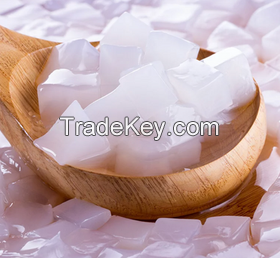





سعر فوب
أحصل على آخر سعر0.7 ~ 2 USD / Kilogram ( Negotiable )
|1000 Kilogram Minimum Order
بلد:
Vietnam
نموذج رقم:
Lena Coconut Jelly - +84378686206 - TR428
سعر فوب:
0.7 ~ 2 USD / Kilogram ( Negotiable ) أحصل على آخر سعر
الموقع:
Vietnam
سعر الحد الأدنى للطلب:
0.7 per Kilogram
الحد الأدني للطلب:
1000 Kilogram
تفاصيل التغليف:
As Customer's Request
موعد التسليم:
15 days
القدرة على التوريد:
10000 Kilogram per Month
نوع الدفع:
Western Union, L/C, T/T
مجموعة المنتج :
Introduction to Nata de Coco / Coconut Jelly
Raw Nata de Coco, or Coconut Jelly, is a refreshing, chewy jelly-like food product made from coconut water, known for its unique texture and mild, pleasant taste. Originating in the Philippines, Nata de Coco has since gained global popularity as a versatile, health-conscious addition to beverages, desserts, and snacks. High in fiber, low in calories, and fat-free, this tropical delicacy has become a staple in various recipes, particularly in Asian cuisine, adding a delightful texture and enhancing the overall sensory experience.
Origins and Cultural Significance of Nata de CocoNata de Coco, which translates to "cream of coconut," was first developed in the Philippines as a way to use surplus coconut water. It became widely known for its unique, chewy texture and the fermentation process that gives it its jelly-like consistency. Traditionally, Nata de Coco has been enjoyed in drinks and desserts, such as halo-halo, a popular Filipino cold dessert. Today, it is enjoyed worldwide, particularly in Asia, for its ability to add a fun texture to dishes while being low in calories and high in dietary fiber.
How Nata de Coco is MadeProducing Nata de Coco involves a meticulous fermentation process that transforms coconut water into a jelly-like substance. Here is an overview of the process:
Fermentation: Coconut water is mixed with sugar and a bacterial culture, then allowed to ferment. The bacteria, Acetobacter xylinum, produces a gel-like cellulose structure, transforming the coconut water into Nata de Coco.
Cutting and Soaking: After fermentation, the thickened product is cut into small, bite-sized cubes. These cubes are then washed and soaked in water, often for days, to remove any remaining acidity.
Final Rinse and Packaging: The Nata de Coco cubes are rinsed thoroughly and packaged, ready to be added to a variety of recipes.
This process not only creates Nata de Cocos distinct texture but also helps retain the natural nutrients and dietary fiber that make it a nutritious addition to any diet.
Nutritional Benefits of Nata de CocoNata de Coco is known for its health benefits, making it a nutritious option for those who enjoy light and refreshing treats. Here are some of the key health benefits:
High in Dietary Fiber: Nata de Coco is an excellent source of dietary fiber, which aids in digestion and supports a healthy gut. Regular consumption can help promote digestive health and alleviate constipation.
Low in Calories: With only about *0 calories per **0 grams, Nata de Coco is a guilt-free addition to various dishes. Its low-calorie count makes it ideal for weight-conscious individuals.
Zero Fat and Cholesterol: Nata de Coco contains no fat or cholesterol, making it suitable for heart-healthy diets and anyone watching their cholesterol levels.
Hydration Support: Made from coconut water, Nata de Coco contains electrolytes that help maintain hydration, making it a refreshing ingredient in drinks.
Gluten-Free and Vegan: Naturally free from gluten, animal products, and allergens, Nata de Coco is a versatile and inclusive food suitable for people with dietary restrictions.
Nata de Coco is a highly versatile ingredient that can enhance a variety of dishes with its chewy texture and mild, refreshing flavor. Here are some popular uses:
In Beverages: Nata de Coco is widely used in bubble teas, fruit juices, smoothies, and yogurt drinks. Its chewy texture adds an exciting twist to these beverages.
In Desserts: Often found in fruit salads, parfaits, and frozen treats, Nata de Coco complements fresh fruits and ice creams. Its particularly popular in layered desserts and tropical treats.
As a Snack: Many people enjoy Nata de Coco straight from the package as a low-calorie, satisfying snack. It can be eaten alone or with a splash of flavored syrup.
In Asian Cuisine: Nata de Coco is a staple in various Asian desserts, particularly Filipino halo-halo, a cold dessert that combines shaved ice, fruits, jellies, and evaporated milk. Its also used in Thai and Japanese dishes for a tropical touch.
Garnish and Toppings: Its unique texture and appearance make Nata de Coco an attractive topping for cocktails, cakes, and frozen yogurt. Its a simple yet elegant way to add a refreshing bite.
To keep Nata de Coco fresh and maintain its texture, follow these storage tips:
Refrigerate After Opening: Once opened, keep Nata de Coco in an airtight container in the refrigerator. This helps preserve its texture and freshness for up to a week.
Store in Syrup: If your Nata de Coco comes in syrup, make sure it stays submerged to retain moisture and prevent drying.
Use in a Timely Manner: For optimal flavor and texture, use Nata de Coco within a week after opening. Discard any Nata de Coco that has changed in color or texture, as this could indicate spoilage.
| بلد: | Vietnam |
| نموذج رقم: | Lena Coconut Jelly - +84378686206 - TR428 |
| سعر فوب: | 0.7 ~ 2 / Kilogram ( Negotiable ) أحصل على آخر سعر |
| الموقع: | Vietnam |
| سعر الحد الأدنى للطلب: | 0.7 per Kilogram |
| الحد الأدني للطلب: | 1000 Kilogram |
| تفاصيل التغليف: | As Customer's Request |
| موعد التسليم: | 15 days |
| القدرة على التوريد: | 10000 Kilogram per Month |
| نوع الدفع: | Western Union, L/C, T/T |
| مجموعة المنتج : | Coconut Product |




